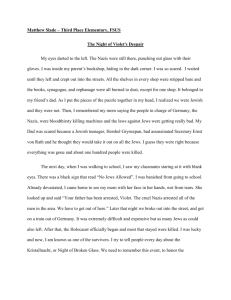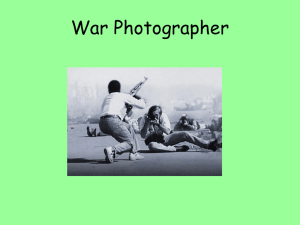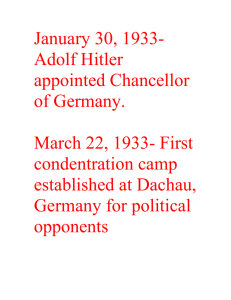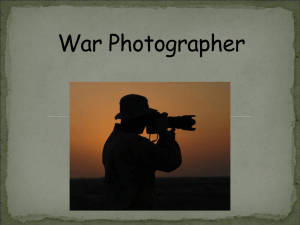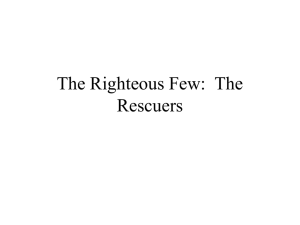Use of present tense/second person (you)
advertisement
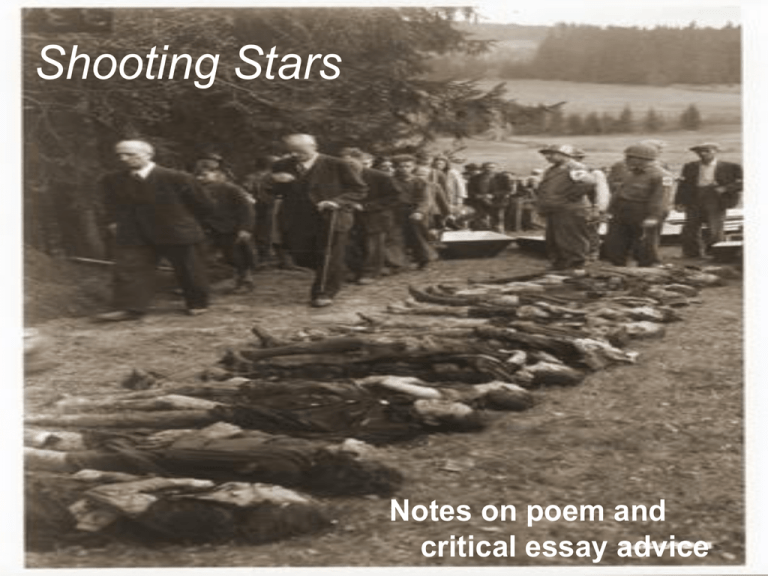
Shooting Stars Notes on poem and critical essay advice Shooting Stars – key features of form and why used. Dramatic Monologue – Duffy adopts persona of a Jewish prisoner so that she can better understand what these women endured during WWII to help prevent such horror being repeated in today’s society. Makes it easier for us to identify with character. Conveys first-hand experience = thoughts and feelings Use of first person narration (‘I’) – third person narration is detached, we can’t identify with a specific person as he/she is used – more anonymous, first person makes us aware that we are focusing on a specific person, their thoughts/emotions/ plight and helps bring more gravitas to the woman’s suffering. Duffy is giving this woman a face/individuality/identity when ironically the Nazis see her only as part of a collective identity – Jewish. Use of present tense/second person (you) Present tense – whole point of poem is to make us aware we cannot forget the Holocaust otherwise such horrors could be repeated. She doesn’t use past tense as it locks these events in the past. Present tense gives events sense of immediacy and confronts us with the horror. It makes it appear as if these events (rape/torture etc) of the women are happening as we read poem – horrific/deeply unsettling – also suggests this is still occurring throughout the world today. Link with second person – puts us in the camp/situation of the women and asks how we would feel – prevents us from being passive as we almost find ourselves in the camp looking on in the situation (and almost participating by failing to prevent it) and forces us to be more active in finding solutions to these issues in today’s society. Shooting Stars Significance of the title: The title has multiple meanings which engage the readers’ emotions and convey the horror of the situation: 1. Shooting of the Jews adorned with the Star of David – had to wear on their clothes to identify them as Jewish – they were seen as having no individuality – see poem. 2. Metaphoric comparison of the Jews with meteors called shooting stars, which are beautiful and unique, but also short-lived. 3. Sarcastic reading = reference to the Nazis themselves. This reading implies that the soldiers were ‘stars’ at shooting the Jews. Rebecca Rachel Ruth Aaron Emmanuel David, stars on all our brows beneath the gaze of men with guns. Use of first person - First person is more direct – it engages the emotions moreofeffectively thewishes use of to a detached ‘our’readers’ suggests the number sufferers –than Duffy convey that Use of present tense (‘speak’, ‘break’ etc.) makes usto feel narrator simply recounts events. It brings the situation life;as this is notwho an unusual/individual occurrence – there were countless if this is‘No just takingspeak’ place, againtoincreases the horror,or longer which pretends be events dead to makes it during seem more to the reader ofsurvive poem more sufferers WWIIreal punished for their(makes cultural/religious identity. revulsion and pity we feel. Suggests torture, rape, murder shocked intoetc. silence by us what she has experienced or disturbing/immediate). This helps to realise the suffering which etc. is already experienced by many women today = D’s main point deadthey and Duffy is reanimating give her the wasour caused. ‘break fingers’ – shows are holding hands to her offertoone another womenvoice/life are still suffering/being oppressed learnt that their was compassion/gentility taken from her? we have solace/comfort – reveals despite the nothing from the past. atrocity/violence they are enduring. After I no longer speak they break our fingers to salvage my wedding ring. Rebecca Rachel Ruth Aaron Emmanuel David, stars on all our brows beneath the gaze of men with guns. Mourn for our daughters, D’s uses of alliteration – furthers the contrast the Nazis/Jews: the Star of David metaphorically described by DThese asbetween being tattooed onthem prisoners’ All Jewish names. Names identify people. names identify as soft ‘b’ sound used the Jews, whereas thebe harsh ‘g’ sound is used to foreheads asso ifisaUse target for the soldiers who will doing the shooting – again offor personal possessive pronoun – emphasises how being Jewish draws attention to their cultural ID which sentences them Daughters Shows (poem the is about male aggression, soto describe the Nazis (guns = violent). nature of each: the Jews are ‘Salvage’ – names interesting choice -–usually means to save something builds on idea that religious/cultural identity marks them for death. littletheir thelexical women have no identity, no freedom, and her death. Their separate them from everyone else – the Nazis see them poet’s sympathies areare obviously withbrutal women). gentle people who are victimised; the Nazis the harsh, oppressors. of value from a wreckage. Here, this word shows the brutality of thenames theasring = symbol of love/marriage/connection with as Jewish and not individuals and that is why speaker gives us Women have sons who go on to perpetratetheir this – woman’s persecutors as it suggests they value the ring more than her Again D suggests their personal identity (earlier use of names) has been is taken due tosays the small monetary valuepoem. the – so they have a another voice/ are notwhy forgotten = Duffy’s point inthem. writing that’s she to mourn for ‘beneath the gaze’ =material suggests superiority of Nazis –are consider Jews beneath life. as They value goods over the lives others. Duffy uses erased to the Nazis they are all marked by the of same symbol. Only identity Nazis will gain from it – the women left with nothing of Suggests Jews passive/can to more escape the men Lack of commas –the suggests more names come and vs. so people will contrast to compare theare gentle natureto ofdo thenothing Jews the brutality of =them. Jewish. their own. deciding who will be next to die – standing withetc. guns. suffer because of their cultural identity – this regarding continueswomen today 9/11 Nazis. Mourn for the daughters, upright as statues, brave. Use simileperson compares theiswomen statues.Another It tells us thatOr they areDuffy brave Use of of second – who ‘you’? to – soldier? Jew? us? because like statues women don’t move. Even when they are facing could be blaming us forthe doing so little to help those who suffer today – and here death, they stand upright and do not flinch or cower. It may also tell us of suggests our complacency in doing nothing and almost watching passively the fear theaswomen They not be able to not move through without care others experience. suffer – ‘waited formay the bullet’/ ‘would look at me’ – fear – they may be petrified. (Petrified = from the Greek word for stone. Its through our own guilt/lack of action to prevent/or even acknowledge how these literal suffered? meaning isSuspense/tension ‘turned to stone’. –Statues are often stone sobut thisare women fellow Jews knowmade whatof will occur is an effective comparison). powerless to prevent it – enhances their suffering/pain. upright as statues, brave. You would not look at me. You waited for the bullet. Fell. I say Remember. Remember these appalling days which make the world for ever bad. One saw I was alive. Loosened ‘Remember. Remember’ - Repetition forline/stanza emphasis and intensity. Use of enjambment – carries on to next – Nazi soldier is Impersonal – shows they (Nazis) are without Duffy’s whole intowriting this poem is for us to ‘Fell’ - Image ofpurpose herand slumping to the ground after the shot. At start and of line – stress it. loosening Important words go there. taunting his end victim starts slowly his belt –understand she knowshow she will identity to the Jews as the Nazis all treat the Jews such occurred and how ifher our actions/views on atrocity others Connotations (suggestions) implies: to ‘fall’ in such wartime. Thosedo who Duffy ishorrors emphatic the fact she wants an be raped and have he (forceful) does this about toword increase fear. Use of enjambment – in the same way – torture/afflict pain etc. It is just not (soldiers improve, people towere survive. died in battle) continue Jews too innocent victims of the war. inthis remembered. She doesn’t want people forget has happened slows down rhythm aswill eye travels to thetonext linewhat and we can imagine another soldier who will cause more suffering. the and waiting what suffering could again in the future wesee failwhat to beis poorpast, women for the inevitable (asoccur we passively readif to Duffy asthe a other feminist focuses onshe plight during war tolerant of races/religions etc. happening) to occur knowing is powerless to helpWWII it. D –ismost deliberately ‘make world forever bad’ –women’s even if we pretend/fail to acknowledge poetry focuses on men theseeing battle field. Shewomen sees the graphic here so wethe can notwho shy died away from what by the such events occurred, the world willon forever be tainted women ascapitalised just aswe courageous/noble and is shocked atthe how they have The ‘R’ is for implicit emphasis too. endured. Again are this woman’s suffering as thetopresent power/prejudice unless we useinour understanding of past help been forgotten. tense draws in to thefrom eventbeing as it repeated. occurs – deeply traumatic and prevent suchussuffering disturbing to the reader which is what D wants – to shock us in to action. Remember these appalling days which make the world forever bad. Between the gap of corpses I could see a child. ‘gape’ - facial expression – disbelief, surprise. Metaphorically it is applied to – thisand lexical suggests extreme violence (a ragged edge is her‘Ragged’ bowels here, not choice her face. No face is mentioned here. Suggests she resulttoofhim, ripping here to the which is is the faceless onevigorously) of many, not an applies individual. Herwoman’s identity flesh has been ripped He apart the brutality of thewomen rape – deeply harrowing forshame/guilt us to think etc erased. hasindone this to many and causes him no about and D is deliberate in upsetting here so we don’t easily the – deplorable how the women’s suffering us is meaningless as they do forget not view aggression of this image. them as individuals. his belt. My bowels opened in a ragged gape of fear. Between the gap of corpses I could see a child. The soldiers laughed. Only a matter of days separate this from acts of torture now. They shot her in the eye. ALack gap in suggests traffic ishope/life/vitality busy; will only last Children Again of traffic emotion symbolise/represent factual from statement the soldiers conveying overgap their the action inevitable etc. –which they –aDsecond. is can and echoed grow the up in to make D’s short reader a difference sentence know that in/casual the thefuture. women tone–Here she will doesn’t this encounter child’s need constant lifetoiselaborate cut torment short on which how As thefeels child is inNazis the gap ofdeath. corpses it suggests there areso corpses again she from suggests towards the D’sthe doubts until soldiers’ of aactions brighter Death –almost and shemore has appears been tolerant amany comfort shocked society. – by and the be one in ‘They shot herdeadened in the eye’by – the thechild Jews’ seewill stanza suffering 5. soon that sheconfirmed too has been emotionally statement emotion attached to it – the Jews have seen this happen repetition–oflack the of atrocities. so many times before, they have had to shut down emotions to enable them to cope – again applies to us here – seeing the same event occur repetitively in today’s world (e.g. war, famine etc.) it can fail to register an emotion – D wants to be overwhelmed with sorrow and pity every time it occurs so we see and empathise with each individual who is in pain. Only a matter of days separate this from acts of torture now. My bare feet felt the earth and urine trickled down my legs until I heard the click. Not yet. A trick. Use of rhetorical question/ second person - invokes the reader directly. It places us right there in the horror of the situation and asks us to consider how we would face death – again puts us in a very uncomfortable position as D is asking us how we would try to cope in this situation/environment – again to provoke us in to reaction – wanting us to avoid intolerance in the present. How would you prepare to die, on a perfect April evening with young men gossiping and smoking by the graves? My bare feet felt the earth and urine trickled down my legs until I heard the click. Not yet. A trick. Bodily functions theextremity of the woman’s terror – again here in April Easter –highlights Crucifixion Jesus’ sacrifice to save mankind. Speaker DSuggests further exemplifies sensitivity of the the cruel Jews and – sadistic in touch nature with of the Nazis the soldier taunts victim by thinktheir the gun is loaded. theNazi poem wants us tohis remember tomaking preventher it happening again. Duffy believes who surroundings/God remain unaffected etc. by the torture they have inflicted on the Jews/these women died inand vainwe because haven’t from ‘Not yet’ – again she knows too arewe aware thatlearnt she will be it. shot. Jews. Use of ‘bare’ – suggests vulnerability of the Jews – The impression of mental torture the mirrors woman suffers is life emphasised by the short The soldier takes sadistic pleasure fromtheir toying with his victim. exposed/unprotected etc. which position in Contrast of April and Death. Spring symbolises new etc. and by sentences and the end of thethis line. Full stop = strong punctuation mark – and We naturally feel intense sympathy for the Jews and hatred society/the world during time. contrasting with the women’s imminent deaths it strengthens thetowards emotion creates and creates tension and a real sense of the experience of the the aNazis. makes itpause more poignant/powerful. woman. Evening – day– coming to a‘trick’closeThis symbolises of the Jewsby within the Internal rhyme ‘click’ and echoes the the lives pauses created the full campand coming to an the endnear = certainty which this will occur – night mustas stops, recreates silencewith the woman would have experienced come etc.to hear the click of the gun. (onomatopoeia) she waited After the history lesson children run to their toys the world turns in its sleep D uses parallelism/parallel sentencing to convey that the event has been forgotten by the world in general – ‘after’ suggests time has passed since these Again suggests it could be anyone as events which makes it easy for us to ignore what has happened. Duffy is trying we know this torment was not an to create awareness to make us remember (compare with repetition of isolated case – compare – ‘one’ / ‘they’ ‘remember in stanza 2.) parallelism = sentencing / repetition = word choice (could link to use of present tense) After immense suffering someone takes tea on the lawn, After the terrible moans a boy washes his uniform. After the history lesson children run to their toys the world turns in its sleep the spades shovel soil Sara Ezra… The firsttofour stanzas are horrific due to the ofthe theextent action, Interesting lexical choice – why do suggests you think D uses here? What does Links Ellipsis (…) idea incomplete of ‘boy’ soldier sentence: in previous linedescription and list of shows dead could go on ofbut and theit on Alliteration Contrast between - repeated the ‘s’ horrific sound and (soft) the reinforces domestic the – clearly idea of alludes sleepy to stanza 5 is perhaps even more horrific because of the juxtaposition of to the Again D forces us too to see them as individuals rather than as a collective suggest about this boy soldier who has committed rape? Is D trying Continues previous idea – idea of sleep = lack of attention/forgetfulness damage unless we ignorance put an end cantocause such –prejudice/ boy knows suggests no other they wayhave to treat been these forgetfulness. the rape (‘terrible ‘sh’ sound moans’) (harsh) and torture to see help (‘immense us remember suffering’) what occurred thus D 5-6 – the horrific with the domestic. This contrast serves to heighten the horror of identity which is how the Nazis too them – we often think of the reduce his culpability? over what has occurred in the past – ‘turns’ – almost shunning those who prisoners forgotten so andthis were propagates never known the violence as individuals – it keeps so the continuing list of all as those it does who the poignantly reality of depicts it is disturbing how commonplace and this is why these we events strive so have vehemently become to situation (could compare with April/death of stanza 4). The reader feels million Jews perished but perhaps never truly think about the livesofof have by metaphorically turning our backs on them and we are today diedsuffered can’t through bewho completed lack of understanding (mass graves/incineration/lack of different cultures/religions. or destruction Suggests through lack of education/guidance this boy is emulating those avoid/ignore and again the it. lack of remorse/guilt in the Nazis (could compare sympathy and pity for the Jews. It is horrific because it draws our attention the victims each as an individual. Lack of commas again to show they are therefore notas honouring/respecting their memory. recordshim etc.) around children/teenagers do – has no suitable role model with stanza 1,as 3, individuals 4 etc.) – these truly abhorrent children’ here are us or today’s children despite knowing about to‘the the way these atrocities have become commonplace obviously not divided up but rather only who everactions seen(parallels asagain a group/one amongst the Nazis and subsequently isthe doomed to repeat Continued in line where D to personifies shovels – shows again(‘the the provoke usnext tocamps contempt/anger for thehe perpetrators. WWII prisoner still ‘run [our] toys’ after hearing abouttheir them with today) identity. Again lack of punctuation esp. lines 3-4 speeds up the rhythm of the poem atrocities. lack of feeling attached to the burial/deaths occurred many history lesson’) as we are more focused onas thehave triviality of ourso own lives to echo how frequently these events occurred and again shows how times before and thismoans is exemplified by the to shovels digging the graves on if rather than the profundity ofaothers’ suffering. D continues to bring us e.g. ‘After the terrible boy washes his uniform’ suggests rape or Likewise D suggests that we are doomed repeat the errors of the past rapidly lives can be lost through failing to accept other cultures/ one race their own deep formoans’ the innocent Jews directly in Creates to the poem tosympathy force us to analyse/contemplate murder has just taken place (‘terrible of anguish/distress). we too do not have better education/guidance (link to nextour lineown of The stanza) believing themselves to be more dominant etc. actions/ignorance so we no longer complacent. soldier casually washes hisare uniform which shows his lack of guilt/anxiety over what he has just done etc. Tell them I sang the ancient psalms at dusk inside the wire and strong men wept. Turn thee unto me with mercy, for I am desolate and lost. Rhetorical question/ second person – we should all consider each other even if we are far apart/ a different race/culture/religion – (again note how D is directly appealing to women here to remember each other so women are treated as equal to the men who fell during the war. ) (Also ‘seas part us’ metaphor for being separated/marked apart from rest of humanity because of religion/time etc) but D forces us to see that this does not give us an excuse to forget. Sister, if seas part us, do you not consider me? Tell them I sang the ancient psalms at dusk inside the wire and strong men wept. Turn thee unto me with mercy, for I am desolate and lost. Psalms songs from Old- Testament. believe onlywhen in the Old role reversal it’sJews more accepted ‘dusk’ (compareculturally with ‘evening’ stanza 4 – dusk = ending of ‘them’ – everyone who’s left (fellow Jews to affirm their faith.) Itupon is likely this Testament. Usually psalms were about tolerance, strength and absolute Comes from the ‘turnare thee me, have women Men theunto ones are meant the daypsalms: =cry. symbolises another lifewho isand about to mercy endto–be again me; for also to the as deliver the woman wishes them to know that despite faith indesolate God as deliverer (to them from It’s evil). psalms have a I amapplies andNazis afflicted’ again suggests remembrance. brave, but here they are theThus, women suggests endless cycle of crying. suffering, death etc. who everythingsignificance they have herDuffy’s spirit/taken her faith/religion – particular for beaten/subdued Jewish prisoners. have thenot strength here shows admiration. clearly D demonstrates these women to be as brave asit the soldiers who purpose in writing the poem confirmed here - returns to the plea for Also the extremity of thejust that even IfD’s you’re singing a shows football song – is what does itsuffering assert? – who you supportso lost their lives for their country/beliefs and thus they deserve to be as remembrance (turnstrong to me, looktoattears. me, remember men it’s somethingbrings about your identity. Nazis wanted tome). wipe out Jews – leave no honoured/remembered as the men. trace of them/obliterate their identity. Therefore, she is singing something that asserts her identity, who she is – this has not been conquered shows bravery, defiance, championing the culture she was born into. Key themes explored in ‘SS’ • Brutality and suffering of war • Intolerance/Prejudice • Oppression of women by men Purpose of the Critical Essay • A DISCURSIVE essay on a text • Presenting an ARGUMENT – a clear line of thought which is linked throughout and is fully developed. • Asserting your genuine personal response/interpretation of the text. • Conveying a CLEAR FOCUS and fully addressing the task – not everything you know or can remember about the text. If you do not answer the ? – the essay will not achieve a pass. Features of a Critical Essay • Don’t forget that you are presenting an ARGUMENT so you will use the same techniques as in discursive writing: - Introduction which clearly introduces your line of argument. - Clear and fully developed points. - Justification using evidence (textual evidence such as quotations) and explanation. - Clear structure which helps develop argument – topic sentences, sub-conclusions, linking, transitional markers. - Conclusion which sums up your argument. Assessment of a Critical Essay The assessment criteria is divided into 4 main areas: • UNDERSTANDING • ANALYSIS • EVALUATION • EXPRESSION UNDERSTANDING Display an UNDERSTANDING of WHAT the text is about. WHAT happens in the text THIS INCLUDES: (understanding of the key aspects and main issues of the text) • WHAT the text is about (THEMES and Writer’s PURPOSE – what are they saying about the themes, what are the messages to the reader about the Human Condition?) Your Understanding of the texts is vital because if you don’t fully understand the text then you cannot go on and analyse and evaluate effectively. ANALYSIS Identify and ANALYSE HOW the writer achieves certain effects and their overall PURPOSE. THIS INCLUDES: • Identifying TECHNIQUES the writer uses and explaining their effects. • Selecting key quotations and textual evidence and explaining why they are importance in the text – what is their effect, what do they show? Although you will be looking at individual techniques and focussing on specific aspects of the text to analyse their immediate effects, it is also crucial that your Analysis has a more holistic dimension to it, looking at the overall effect of all the techniques and HOW they help the writer achieve their OVERALL PURPOSE – this will be linked to the focus of the task. EVALUATION EVALUATE HOW EFFECTIVE the techniques used by the writer are in achieving their intended effect and overall purpose. THIS INCLUDES: • Assessing the effectiveness of the techniques and the text as a whole and giving a genuine personal response. • Using evaluative language: successfully, clearly, cleverly, is effective in… Even though you must give a personal response, remember that it is a formal essay so you should not write ‘I think…’ EXPRESSION •Expressing yourself well in an essay requires good writing skills: word choice, sentencing, punctuation, spelling and paragraphing are all important. It also refers to your use of appropriate critical terminology, e.g. reference to characterisation; setting; the use of rhyme. • Your expression should be formal and varied and you should use technical language competently. You must take responsibility for any areas of weakness and try to address these by asking for advice or resources to help you. Critical Essays: • Focus on the question as fully as possible. • Select relevant quotation and analyse fully (the analysis here is the working out in maths.) • Always write in present tense (the text still exists). • Use varied and sophisticated vocabulary/sentencing. • Fully evaluate what the writer/poet/playwright is doing, why and how this is effective (e.g. 1st person instead of 3rd person narration in ‘SS’?) • Link to key themes and the purpose of writer/poet/playwright – shows a full and comprehensive understanding of the key features of the text. 2003, Q14 Answers to questions on poetry should address relevantly the central concern(s)/theme(s) of the text(s) and be supported by reference to appropriate poetic techniques such as: imagery, verse form, structure, mood, tone, sound, rhythm, rhyme, characterisation, contrast, setting, symbolism, word choice… Choose a poem in which the poet has created a perfect blend of form and content. Show how the poet achieves this and discuss how it adds to your appreciation of the poem. The Critical Essay Structure INTRODUCTION The function of the introduction is to clearly introduce the topic of the essay and set up the line of argument. KEY COMPONENTS: • Title of the text, name of writer and type of text • Introduce focus of essay (the line of argument) – do this by referring to the task/ use the key words of the ? • Outline the areas the essay will cover – character, setting etc. (this ensures you have task and how to approach clear in your mind. • Use evaluative/emotive words (e.g. poignantly, harrowing etc) Introduction Carol Ann Duffy’s evocative and brutal poem ‘Shooting Stars’ is the horrific account of a Jewish woman about to be killed by Nazi soldiers in World War II. Duffy’s use of the dramatic monologue form in harmony with key features of content reinforces her message that we should remember the atrocities committed against the Jews during WW2. Main Argument You should ALWAYS clearly plan out the aspects of the text that you are going to deal with in the main argument before you start writing. Your argument needs to be clear, logical and well thought through. Consider: • What is relevant to the task • The key points you want to make in each section • What quotations or textual evidence are you going to use to illustrate your points. • The appropriate order of the points/paragraphs • How you are going to link the points/paragraphs together. •Varied and complex sentencing: •e.g. typical topic sentence (too basic/can become repetitive) Duffy uses imagery to convey the horrific torture of the Jewish women by the Nazis. Through clever and extensive use of imagery, Duffy harrowingly depicts the torture the Jewish people endured within the camps. Poignantly, the poet exemplifies the barbarity of the Nazis towards the Jewish, through the horrific and graphic imagery employed. Quotation Layout (you can use a mixture of both methods): If 2 lines or more or if simply too difficult to integrate: Poignantly, Duffy exemplifies the barbarity of the Nazis towards the Jewish, through the horrific and graphic imagery employed. The atrocities committed are described in vivid detail: ‘One saw I was alive. Loosened his belt. My bowels opened in a ragged gape of fear.’ The graphic and brutal nature of a rape is expertly conveyed here through the use of enjambment. By…. Remember to drop down a line and separate out the quotation by indenting it slightly. DO NOT indent the analysis that follows – it is not a new paragraph (just drop to next line and continue writing next to the margin. Or integrating: (tip - use a conjunction) Duffy poignantly portrays the brutality of the Nazis by depicting the graphic rape of one of the prisoners, and the fear and torment she endured as ‘[her] bowels opened in a ragged gape of fear.’ Thus, … Duffy highlights to the reader the consequences of forgetting the past which has ultimately made ‘the world forever bad,’ as we cannot hope to avoid the repetition of such atrocities, without, fully understanding why they occurred. Remember to use square brackets to help integrate your quotations more easily. Use […] if you miss any words out The The title title of of thethe poem poem ‘Shooting ‘Shooting Stars’ Stars’ creates creates many many images in theimages reader’s in the mind reader’s which Duffy mind.cleverly It couldemploys mean the to shooting suggest the heroism of the Jews, of the adorned Jews. Although with the Star on aof literal David, reading or could the poet suggests have a much the sadistic deepershooting meaning. of the Imagine Jews,the adorned beautiful withbut the Star ephemeral of David,burst thereofislight a more flying profound throughmeaning the midnight also sky implied. Imagine and you thehave beautiful Duffy’s butmetaphor ephemeral for burst life itself. of light The flying through shooting thestar midnight is beautiful sky and and you unique, have Duffy’s but it is metaphor also dying.for Jewish Duffy life portrays duringthe WWII: life of the the shooting world itself star as is beautiful a short blast and of unique, passion butand it islight, also which dying and all must thuscome the poet to an portrays end. The the life of thetitle Jews reinforces as a short the blast fact that of passion any death, and no light, matter which how tragically comes dramatic to a or premature small, is and still heroic brutal end. and brave. Subsequently, the deaths of these peaceful and noble Jews are made all the more deplorable due to the violent and horrific manner in •Strengths? which they were obliterated. •Areas to improve? The poem begins: ‘After I no longer speak, they break our fingers to salvage my wedding ring.’ The image in the reader’s mind is horrific. The word ‘salvage’ shows the brutality and greediness of the Germans who did this to her. This line is written in the present tense, bringing the events of the Holocaust closer to us and shocking us greatly with how this woman’s fingers were broken, Duffy whilstcleverly she wasconveys actuallythe stillbravery alive. and noble heroism of the Jewish woman as she ‘no longer speak[s],’ wishing not to give any satisfaction to the soldier who has broken ‘[her] fingers to salvage [her] wedding ring.’ Here we understand that despite the savagery of this act, this woman stands brave and resolute determined not to show her pain. This brutal act juxtaposed with the pathetic greed of the soldier exemplifies the magnitude of the woman’s suffering as he ‘salvage[s]’ the only possession she has left. Poignantly, Duffy’s lexical choice here reflects the true horror of the situation as ironically ‘salvage’ means to save something of value, and here the most valuable asset of all, this woman’s identity, valour and courage However, the poet does on the persona’s But this poem is not justnot thesolely tale offocus the persona’s acts of acts of bravery,She rather she is making a more universal statement; bravery. is unnamed and therefore, for me she could be the suchJews torment unnamed and therefore, anyJew oneexperiencing of the six million whoisdied in the Holocaust. for meisshe could be anyofone of the six million JewsThe who were This a sad reminder all the people who died. annihilated in theacross Holocaust. Through for theme, list of namesshe persona comes as a heroine, because ‘Rebecca Rachel Ruth Aarona Emmanuel David’ reminder. and the lack attempts to give the reader sad but important of anylists punctuation, Duffy skilfully reminds the reader that She the names: ‘Rebecca Rachel Ruth Aaron these lists were never ending, the people who died Emmanuel David.’ The lack ofand anythat punctuation reminds the were notthat justthese statistics, they realand people lived and reader lists go onwere and on, that who the people who breathed. therefore wishes to honour all thewho brave and died were She not just statistics, theyus were real people lived courageous individuals involved, as if we fail to acknowledge and breathed. and respect all the lives that were tragically destroyed, we are failing to honour their memory appropriately. Conclusion The conclusion should bring the essay to a close and sumup the argument in an assertive, clear and concise way. The conclusion is very similar to the introduction in some ways: • Re-state Title, Type and author of text • Clear reference to the task • Re-assert argument with particular focus on task and overall purpose of the text (Evaluative stance) There should be NO new points of analysis or any quotations in the conclusion Conclusion Duffy creates an intense and uncomfortable mood in order to stress to the reader the atrocities and reality of war from the Jewish woman’s point of view. The speaker recites the deplorable events vividly and thus Duffy ensures that they remain imprinted in our minds, so that we are better aware of the failings of the past, and subsequently better prepared to avoid such horrors reoccurring in the future. Conclusion ‘Shooting Stars’ is a story of heroic life being destroyed, but it is a poem with a difference. It does not tell the fanciful tales of the glory of war, it tells it like it is. It tells of the real heroic people of the world, the innocent blood of women and children pooling on the ground in countries such as Iraq and Bosnia. Duffy lets us know that these events are still going on but ‘the world turns in its sleep’ as if we do not care and have forgotten these terrible events. Yet, as Duffy says we must ‘Remember’ and her haunting words from the grave will never be forgotten. We will not forget.

